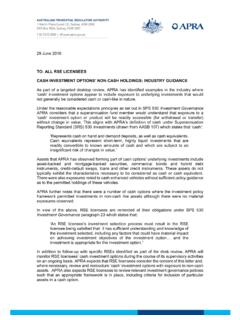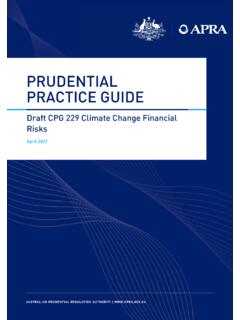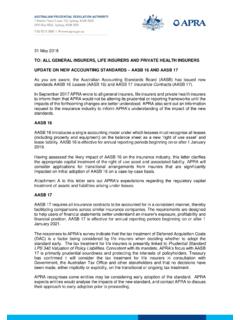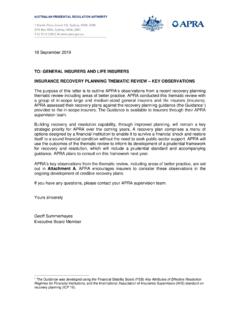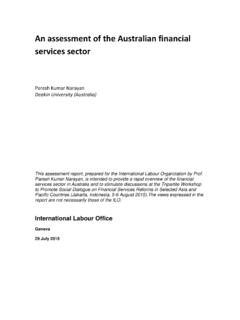Transcription of Re: Royal Commission into Misconduct in the Banking ...
1 Re: Royal Commission into Misconduct in the Banking , Superannuation and financial services industry Written Submissions of the Australian Prudential Regulation Authority (APRA) in response to the Interim Report Summary 1. This submission provides APRA s views on issues and questions posed by the Interim Report that are relevant to APRA s mandate. 2. In summary, there are three overarching questions posed by the Commission with respect to the regulators: First, have the regulators responses to Misconduct been appropriate?
2 Second, how should regulators respond to conduct and compliance risk? Third, should the regulatory architecture change or the law be simplified? 3. In response to the first question, APRA believes its response to Misconduct and Misconduct risk has been broadly appropriate given its core prudential mandate and risk-focused approach. That is, APRA has largely focused its response to matters that relate to prudential risks and on issues that may have a material impact on the regulated entity concerned. APRA s response to Misconduct has focused on strengthening the governance and practices of regulated entities, and taking action to protect the interests of beneficiaries.
3 Public examples of such responses include APRA s recent inquiry into the Commonwealth Bank of Australia (CBA), and its interventions in the residential mortgage lending sector. 4. In response to the second question, APRA agrees with the premise that identified prudential risk drivers, notably governance, culture and incentives, also drive conduct outcomes, and that there is scope to take further action in these areas. In its recently published Statement of Intent, APRA has committed to continue to facilitate the improvement of accountability, governance and risk culture within financial 5.
4 Greater regulatory attention to these areas by APRA can be part of the solution to Misconduct in the industry . While historically APRA's regulatory focus has largely been concentrated on prudential risk taking and long-term financial soundness, the evidence before the Royal Commission highlights the need for APRA to examine the means by which it can more actively contribute to a regulatory framework that limits the potential for Misconduct to occur in the future. 6. Ultimately behavioural change will only occur if boards take ownership for the actions of their organisations and the consequences of those actions.
5 There is a role for APRA 1 APRA, Statement of Intent, September 2018 (SOI): Page 2 of 20 (and the Australian Securities and Investments Commission (ASIC)) here as the regulators in setting and enforcing standards of governance, accountability and risk culture. However, solutions to past problems must involve industry taking more responsibility, not less, for maintaining appropriate standards of conduct and guarding against Misconduct . 7. Regulatory responses to conduct and compliance risk also need to be appropriately tailored having regard to the circumstances of the breach - for example, an operational failure or outage may not warrant formal legal action.
6 To take formal legal action on every occasion may result in financial institutions becoming wary of all but the most simple and low-risk transactions with a much reduced incentive to innovate. This would potentially limit access to, and increase costs of, all financial services . 8. This submission sets out how APRA has taken, or is taking, actions on drivers of Misconduct , including governance, culture and incentives. Specific actions include: 9. With respect to the third question concerning regulatory architecture, APRA s view, as set out in its submission on Round 5, is that the current broad structure of prudential and conduct regulation and responsible regulators should be maintained.
7 Under this structure, APRA s core mandate is focused on safety and soundness while ASIC s is focused on consumer protection. The regulatory architecture which emanates from this structure may at times be complex, but given the nature of the financial services sector, some degree of complexity is inevitable. There are trade-offs between simplicity, on the one hand, and clarity and enforceability, on the other. Some laws, such as the Superannuation industry (Supervision) Act 1993 (Cth) (SIS Act), which reflects an accumulation of specific requirements in a piecemeal fashion over time, may in fact be due for an overhaul.
8 An alternative approach may be to focus on regulated institutions understanding and internalising the principles behind regulatory requirements, than on changing these requirements or how they are presented. Reviewing its enforcement strategy and related internal procedures and governance, including the potential to give greater weight to the strategic use of formal enforcement powers; Strengthening prudential governance requirements, particularly around remuneration, accountability and conflicts of interest (including through the implementation of the Banking Executive Accountability Regime).
9 Utilising the lessons from the CBA Inquiry more broadly by, for example, requiring larger regulated entities to perform self-assessments against the findings of the CBA Inquiry and report those self-assessments to APRA; Deepening its supervisory approach, including focusing on clear accountability, making more regular use of external resources to provide assurance over entities practices, and bringing to bear wider sources of information (such as reported breaches and customer disputes); Collaborating more closely with ASIC and other regulators on matters of Misconduct , particularly in relation to investigations and enforcement activities.
10 Page 3 of 20 10. In summary, the Commission s activities have, to date, provided valuable lessons which generate important opportunities for APRA, other regulators and the industry to improve practices. 11. There is not likely to be a single or straightforward solution to the problem of Misconduct in the financial industry . The way forward is likely to involve a range of complementary measures, involving constructive interaction between institutions, industry bodies, regulators and Government. These measures are likely to include: institutions being committed to incentive structures that reward outcomes for meeting broader community expectations as much as they do financial targets; a clearer regulatory and institutional focus on individual accountability, through incentive structures and appropriate responses to poor outcomes; regulatory powers and resources dedicated to detecting Misconduct and taking action, including formal enforcement where appropriate.

